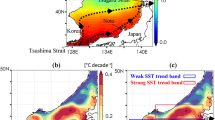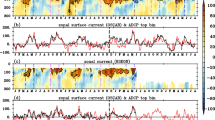Abstract
Our purpose is to calculate waves propagating along the equator in an oceanic domain and the influence of a characteristic mean equatorial circulation on the nature of these waves. Equations satisfied by perturbations of currents and temperature are of the Navier-Stokes type and have been linearized around a stationary solution. Existence and uniqueness of the solution have been proved. Numerical experiments have been carried out and provided us with time-dependent values. The excited waves are exhibited by Fourier analysis of these time series.
Similar content being viewed by others
References
Brossier, F.: ‘Etude numérique d'un problème de Stokes intervenant en Océanographie’, Calcolo 18 (1981), 41–86.
Bryan, K.: ‘A Numerical Method for the Study of the Circulation of the World Ocean’, J. Comp. Phys. 4 (1969), 347–376.
Bryan, K. and Cox, M. D.: ‘The Circulation of the World Ocean: A Numerical Study’, J. Phys. Oceanogr. 2 (1972), 319–335.
Ciarlet, P., The Finite Element Method for Elliptic Problems, North-Holland, Amsterdam, 1978.
Colin-Picault: Personal Communication, 1980.
Cox, M. D.: ‘Equatorially Trapped Waves and the Generation of the Somali Current’, Deep Sea Res. 23 (1976), 1139–1152.
Hallock, Z.: ‘On Wind-Excited, Equatorially Trapped waves in the Presence of Mean Currents’,
Jenkins and Watts: Spectral Analysis and its Applications, Holden Day, 1968.
Lighthill, M. J.: ‘Dynamic Response of the Indian Ocean to the Onset of the Southwest Monsoon’, Phil. Trans. Royal Soc. London, A 265 (1969), 45–92.
Lions, J. L. and Magenes, E.: Problèmes aux limites non homogènes, Vol. 1, Dunod, Paris, 1968.
Moore, D. W. and Philander, S. G. H.: ‘Modelling of the Tropical Oceanic Circulation’, The Sea 6 (1977), 319–360.
Necas, J.: Les Méthodes directes en Théorie des Equations Elliptiques, Masson, Paris, 1967.
Philander, S. G. H.: ‘Forced Oceanic Waves’, Rev. Geophys. Space Phys. 16 (1978), 15–45.
Richtmyer, R. D. and Morton, K. W.: Difference Methods for Initial-Value Problems, Wiley, New York, 1967.
Semtner, A. J.: ‘An Oceanic General Circulation Model. Numerical Simulation of Weather and Climate’, Technical Report. No. 9.
Temam, R.: Navier-Stokes Equations, North-Holland, Amsterdam, 1977.
Weisberg, R. H., Miller, L., Horigan, A., and Knauss, J. A.: ‘Velocity Observations in the Equatorial Thermocline during GATE’, Deep Sea Research, GATE Supplement II to 26 (1979), 216–248.
Weisberg, R. H., Horigan, A., and Colin, C.: ‘Equatorially Trapped Rossby-Gravity Wave Propagation in the Gulf of Guinea’, J. Marine Res. 37 (1979), 67–86.
Author information
Authors and Affiliations
Rights and permissions
About this article
Cite this article
Brossier, F. Mathematical modelization of equatorial waves. Acta Appl Math 5, 37–85 (1986). https://doi.org/10.1007/BF00049169
Received:
Issue Date:
DOI: https://doi.org/10.1007/BF00049169




